Mid-Autumn Festival, which occurs on the fifteenth day of the eighth lunar month, is a time for families to gather and appreciate the full harvest moon with dragon dances, lantern lighting, and gift exchanging. Mooncake is an essential part of the festival, so much so that the festival is colloquially known as the Mooncake Festival. During the month leading up to Mid-Autumn Festival (which falls on 10 September 2022 this year), shops all over Hong Kong sell mooncakes with their own styles, recipes, and branding in preparation for large family gatherings where the lucky pastry, in sweet and savoury forms, is a culinary necessity.
What are mooncakes?
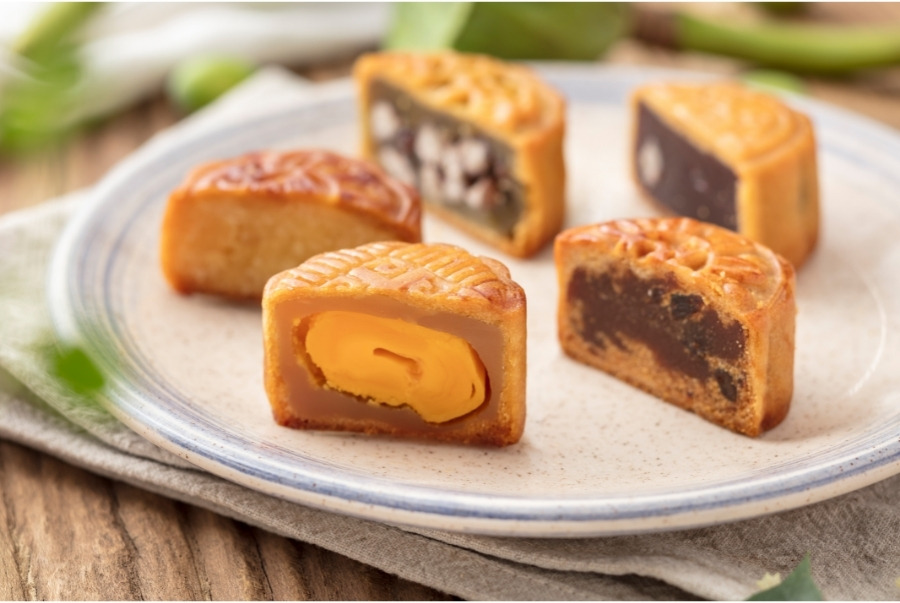
Mooncakes (月餅, pronounced yut beng in Cantonese and yuè bǐng in Mandarin) are a round pastry with a thin, crackly shell and a sweet filling (traditionally, either lotus seed paste or red bean paste) and preserved duck egg yolks. The circular shape of mooncakes, which resemble the full moon at the peak of the harvesting season, symbolize unity and completeness, an important concept in Chinese culture.
Historically, the Hong Kong mooncake crust is made with flour, sugar syrup, oil, and alkaline water to prevent cracks. For the filling, white or yellow lotus seed paste or red bean paste surrounds an entire preserved egg yolk and occasionally contains seeds and other seasoning, as well. Today, various mooncake styles are common during Mid-Autumn Festival season, such as cold dessert ‘snowskin’ mooncakes, lava custard filling, and chocolate mooncakes.
What is the origin of mooncakes?
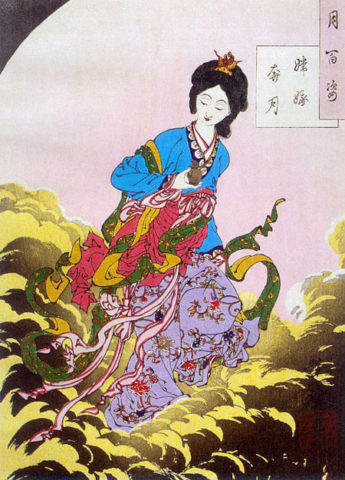
There are a few folktales surrounding the origin and cultural significance of mooncakes. These include a story about Ming revolutionaries using mooncakes to disseminate their messages in order to overthrow their Mongol rulers in the mid-fourteenth century.
However, the most common story surrounding mooncakes is the one about Chinese moon goddess Chang’e (嫦娥, pronounced seung ngo in Cantonese) that originated in the book of Huainanzi (淮南子) during the Han dynasty. The Chinese legend describes how the Earth originally had ten suns that would cross the sky one by one. However, one day all ten suns appeared at once, causing a severe drought. Chang’e’s husband, Hou Yi (后羿), shot down nine suns with his bow to end the drought. For his heroic actions, he was elected to be king.
At this point, there are variations in tellings of the legend.
One variation says that Hou Yi found a potion to achieve eternal life. Chang’e wished to end his rule and drank the immortality elixir herself, escaping to the moon for refuge. In a karmic punishment for her selfishness, she was transformed into a frog.
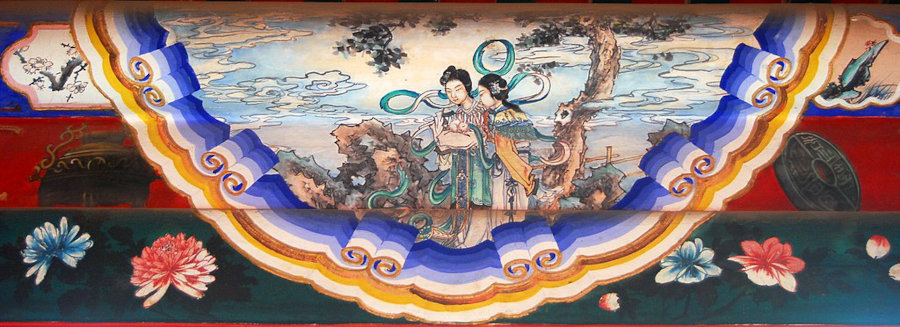
The other version of this mooncake history describes how the Queen of Heaven gave Hou Yi the immortality potion as a reward for saving humanity from starvation. The new king didn’t want to leave his wife, and gave her the potion for safekeeping. A greedy man named Fengmeng tried to take the potion from Chang’e, and knowing she couldn’t successfully fight him, she swallowed the potion and flew to the moon. When Hou Yi discovered his wife was gone, he was devastated and prepared her favourite cakes as offerings in an attempt to bring her back. Unsuccessful, he prepared a banquet every year on that day, the fifteenth day of the eighth lunar month.
Ever since then, Chinese people have observed this festival day to honour Chang’e, the spirit of the moon, and reunite with their family where the mythological husband and wife couldn’t.
How are mooncakes made?
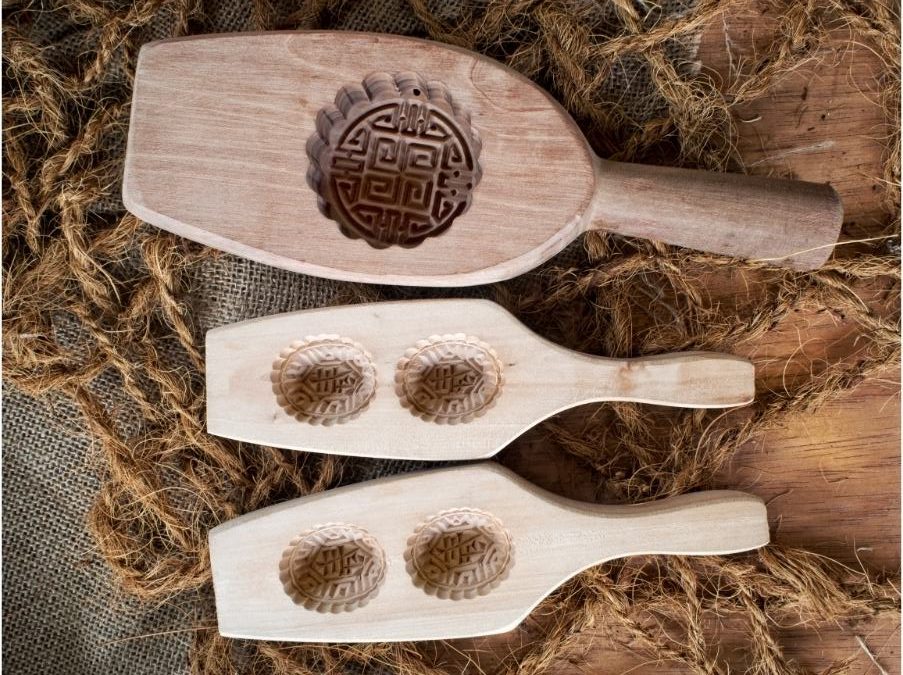
To make a traditional Hong Kong-style mooncake, first, an entire salted egg yolk is moulded by hand into the middle of a ball of dense filling. The roundness of the egg yolk should be carefully maintained at this stage. Then, the ball is wrapped into a round of thin pastry. The ball is then stamped into the ubiquitous uniform mooncake shape by a wood or plastic mould.
The pastry to filling ratio should be approximately 1:2, and the pastry can be made even thinner without breaking at the shaping stage if done by an experienced chef.
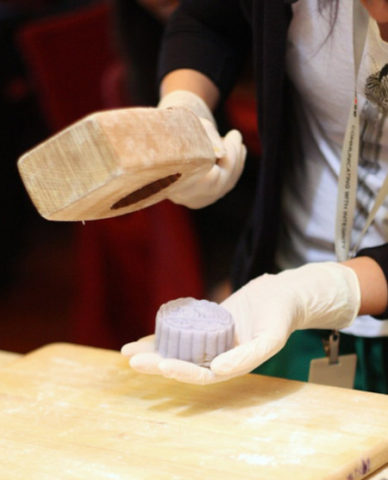
Mooncakes traditionally have Chinese blessing words like “harmony” and “longevity” stamped on the tops as a wish for peace and long life. They are also sometimes stamped with the name of the bakery they came from, or business names when gifted as corporate presents. Other moon-related symbols like rabbits (the loyal companion of the moon goddess is a rabbit) and flowers appear on the crowing decoration.
Stored at room or cooler temperatures, mooncakes can typically last for one to two weeks depending on their ingredients. Fillings made of exclusively lotus seed paste and egg yolk can be kept for longer than perishable ingredients like butter.
What are the different types of mooncakes?
Today, mooncakes come in many modern variations in filling and crust ingredients and flavours. However, the stamps on top still usually carry the motifs of the classic moon legend. There are also regional variations mooncakes throughout China and other parts of Asia. The following are variants on the traditional lotus seed paste and salty egg yolk mooncake seen in Hong Kong.
Snow skin mooncake is a cool, light, dessert-style mooncake. The skin is made with sugar and glutinous rice flour, and sweet red or green bean paste filling is accompanied by fruit, black sesame, chocolate, or edible bird’s nest.

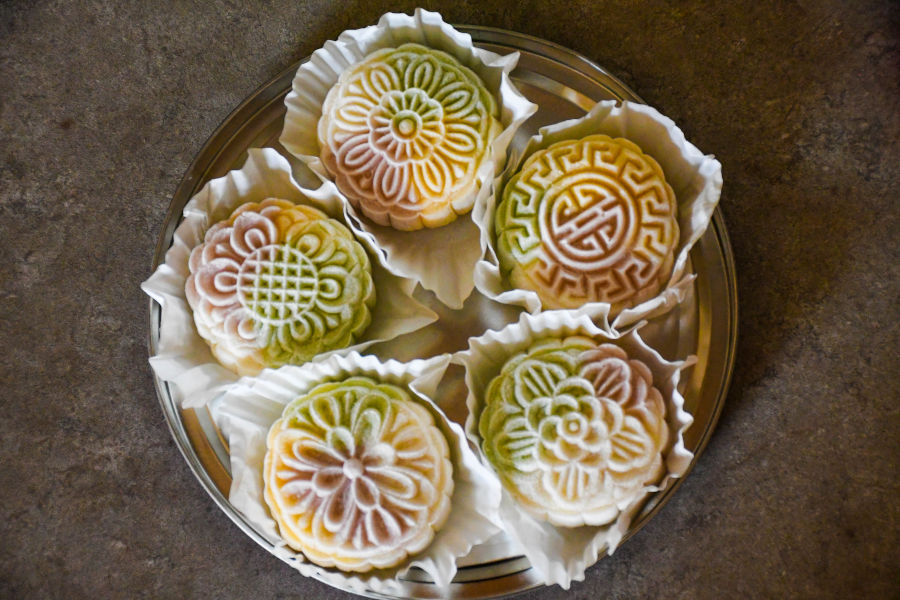

The more fulfilling, decadent lava egg custard mooncake is made with a pastry of flour, butter, egg, and icing sugar. The creamy custard filling is made with a variety of milk and milk substitutes, custard powder, butter, sugar, and salted egg yolk.
Jelly mooncake is a bouncy, usually colourful mooncake with an outer layer made from fruit, coconut milk, water, sugar, and agar powder. The inside is filled with more fruits that imitate the traditional globular egg yolk centre. Still other creative “crystal” mooncakes are made with osthmanthus or longan jellies and filled with drief fruits or flowers.
Mixed nuts mooncake is a traditional mooncake originating from Guangdong, eaten more as a snack or part of a meal, that can contain ham, seeds, nuts, dried fruit, and dried scallops.
FAQ about mooncakes
What is the meaning behind mooncakes?
Mooncakes’ roundness represents wholeness, perfection, and togetherness, which ties in naturally with the appreciation for the full harvest moon during Mid-Autumn Festival celebrated in China and other Asian cultures.
What are mooncakes made of?
The wrapping of mooncakes are made of flour and lard or vegetable oil, and the filling is usually made of sweet, dense red bean or lotus seed paste. More ingredients can be added to the filling, like nuts, salted duck egg yolk, meat, and pounded yam.
What does mooncake taste like?
Mooncakes taste subtly sweet because of the luxurious lotus seed paste, which is counterbalanced with salty preserved whole egg yolks and/or chopped seeds, nuts, and pork.
🌙 More Mid-Autumn Festival guides ⤵️
Header image credits: tsenphoto via Canva




